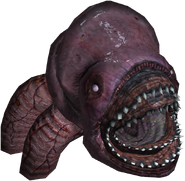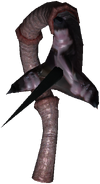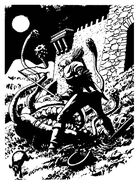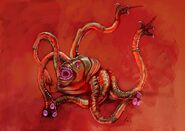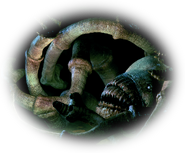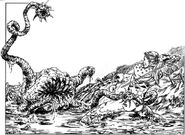m (→Videos: clean up) |
m (Reverted edits by Salemleo89 (talk) to last version by Witcher Bot) |
||
| (19 intermediate revisions by 10 users not shown) | |||
| Line 1: | Line 1: | ||
| ⚫ | '''Zeugls''' inhabit sewers predominantly, feeding on sewage, and grows at an alarming rate. The beast is always hungry, so it reaches out with its tentacles for living creatures and tries to shove them into its huge maw filled with multiple rows of teeth. The zeugl is paralyzingly hideous, foul-smelling, and surprisingly strong for something resembling a rotten potato, so it usually manages to devour its opponent.<ref name="sod">{{SoD}}</ref><ref>{{WGW}}</ref> |
||
| − | [[File:Gra Wyobrazni zeugl.jpg|thumb|250px|''[[Wiedźmin: Gra Wyobraźni]]'' image]] |
||
| ⚫ | [[Geralt of Rivia|Geralt]] was hired to rid the sewers of a zeugl during his and [[Yennefer of Vengerberg|Yennefer]]'s stay in [[Aedd Gynvael]].<ref name="sod" /> There is also a breed of zeugl mutated by [[Rissberg]] [[mage]]s called [[parazeugl]], which in turn is not at all dangerous and cleans the sewers.<ref>{{SoS}}</ref> |
||
| ⚫ | |||
| − | |||
| ⚫ | [[Geralt of Rivia|Geralt]] was hired to rid the sewers of a zeugl during his and [[Yennefer]]'s stay in [[Aedd Gynvael]].<ref name=" |
||
=={{tw1}}== |
=={{tw1}}== |
||
{{Infobox Bestiary1 |
{{Infobox Bestiary1 |
||
| − | | |
+ | |Name = Zeugl |
| − | | |
+ | |Image = Bestiary_Zeugl.png |
| − | | |
+ | |Occurrence = Zeugls live in filth, in sewers or waste dumps; they should be disposed of while they are young and small - a fully grown zeugl is a formidable adversary, even for a [[witcher]] |
| − | | |
+ | |Immunity = Practically immune to sword blows, regardless of whether the sword is steel or silver |
| − | | |
+ | |Susceptibility = To kill a zeugl one has to remove its tentacles first |
| − | | |
+ | |Tactics = They shower their opponents with numerous tentacle hits |
| − | | |
+ | |Alchemy = [[Zeugl venom]] |
}} |
}} |
||
In the game, the zeugl is one of the boss monsters. Geralt must face this ugly beast in the [[Vizima sewers]] during the Epilogue, and this time, the tentacles seem to have a mind of their own! Luckily our hero is not forced to face the beast alone. |
In the game, the zeugl is one of the boss monsters. Geralt must face this ugly beast in the [[Vizima sewers]] during the Epilogue, and this time, the tentacles seem to have a mind of their own! Luckily our hero is not forced to face the beast alone. |
||
| − | === |
+ | === [[The Witcher journal|Journal]] [[The Witcher bestiary|Bestiary]] Entry === |
''"The zeugl is the best example of a monster that has grown accustomed to human settlements. The beast feeds on the waste and filth produced by the city, so it need not hunt or fight to survive. It simply grows and gradually becomes a danger to people. This shows how detrimental continued degradation of the natural environment can be in the long run. Therefore, I implore the reader: respect nature."'' |
''"The zeugl is the best example of a monster that has grown accustomed to human settlements. The beast feeds on the waste and filth produced by the city, so it need not hunt or fight to survive. It simply grows and gradually becomes a danger to people. This shows how detrimental continued degradation of the natural environment can be in the long run. Therefore, I implore the reader: respect nature."'' |
||
| Line 36: | Line 34: | ||
This huge monster inhabiting the sewers beneath Vizima looks like a medieval environmentalist's nightmare. It feeds on the garbage and carrion that slowly drift with the flow. The zeugl can grow to be enormous in size, and being a hermaphrodite, it reproduces easily. A fully grown specimen is a serious threat to humans and very difficult to kill. |
This huge monster inhabiting the sewers beneath Vizima looks like a medieval environmentalist's nightmare. It feeds on the garbage and carrion that slowly drift with the flow. The zeugl can grow to be enormous in size, and being a hermaphrodite, it reproduces easily. A fully grown specimen is a serious threat to humans and very difficult to kill. |
||
| − | Only the top part of its body and tentacles ever surface above the sewage |
+ | Only the top part of its body and tentacles ever surface above the sewage - and these are the most important elements of its design. The black on red sketches present the creature in all its glory. Sapkowski described it as a "hideous bulge" - and such is our zeugl. The concept artist provided it with a fish-like head and a few rows of sharp teeth suitable for grinding whatever reaches the monster's jaws. If the victim is not quite dead, the zeugl's tentacles feature spikes that allow the creature to pull its prey into its mouth.{{Block Quote|text = The debris exploded in an geyser of thick, stinking grease, clay pot fragments, rotting rags and pale shreds of pickled cabbage. From beneath it burst a huge bulbous body, resembling a rotten potato. It slapped the air with three tentacles and the stub of a fourth. (...) The body glided toward him, plowing through the debris like a barrel being rolled to market. He saw the tuber crack as it opened its wide maw full of large, razor-sharp teeth. He let the tentacles wind themselves around his waist, lift him from the stinking grease with a thwack, and drag him towards itself spiralling ever deeper into the debris (...) The tooth-lined jaws snapping wildly and angrily.|citation = {{SoD}}}}The sketch above focuses on the zeugl's cephalothorax - the monster's head resembles that of a fish, while the folds on its back bear a likeness to mushroom caps. |
== Notes == |
== Notes == |
||
* In {{Tw3}}, when Keira slightly recreates her favorite fairy tale, Cinderella, Geralt explains how it was based on a true story where Princess Cendrilla was eaten whole by a zeugl that hid in the palace pond, leaving behind one shoe. |
* In {{Tw3}}, when Keira slightly recreates her favorite fairy tale, Cinderella, Geralt explains how it was based on a true story where Princess Cendrilla was eaten whole by a zeugl that hid in the palace pond, leaving behind one shoe. |
||
| + | * In {{Tw3}}, [[Vesemir]] recalls the time when Geralt fought a zeugl in [[Tretogor]]. |
||
| + | * In {{Tw3}}, during the ball in the Vegelbuds' estate, if the player chooses to play [[Gwent]] with the nobles, his last opponent is said to have a zeugl bone amulet that brings him good luck on the table. |
||
== Videos == |
== Videos == |
||
| Line 48: | Line 48: | ||
== Gallery == |
== Gallery == |
||
<gallery> |
<gallery> |
||
| + | Bestiary_Zeugl_full.png |
||
| − | File:Bestiary_Zeugl.png|Journal image |
||
File:Bestiary_Tentacle.png|Zeugl tentacle |
File:Bestiary_Tentacle.png|Zeugl tentacle |
||
File:Zeugl Polch.jpg|Illustration by [[Bogusław Polch]] of Geralt fighting the zeugl in [[Aedd Gynvael]]. |
File:Zeugl Polch.jpg|Illustration by [[Bogusław Polch]] of Geralt fighting the zeugl in [[Aedd Gynvael]]. |
||
File:Zeugl sketch.jpg|Zeugl cephalothorax from the Monsterbook |
File:Zeugl sketch.jpg|Zeugl cephalothorax from the Monsterbook |
||
Zeugl_full2.png |
Zeugl_full2.png |
||
| + | Gra Wyobrazni zeugl.jpg|{{WGW}} |
||
</gallery> |
</gallery> |
||
| Line 72: | Line 73: | ||
[[ru:Риггер]] |
[[ru:Риггер]] |
||
[[pt-br:Zeugl]] |
[[pt-br:Zeugl]] |
||
| + | [[Category:Wiedźmin: Gra Wyobraźni bestiary]] |
||
Revision as of 19:14, 11 April 2020
Zeugls inhabit sewers predominantly, feeding on sewage, and grows at an alarming rate. The beast is always hungry, so it reaches out with its tentacles for living creatures and tries to shove them into its huge maw filled with multiple rows of teeth. The zeugl is paralyzingly hideous, foul-smelling, and surprisingly strong for something resembling a rotten potato, so it usually manages to devour its opponent.[1][2]
Geralt was hired to rid the sewers of a zeugl during his and Yennefer's stay in Aedd Gynvael.[1] There is also a breed of zeugl mutated by Rissberg mages called parazeugl, which in turn is not at all dangerous and cleans the sewers.[3]
The Witcher
In the game, the zeugl is one of the boss monsters. Geralt must face this ugly beast in the Vizima sewers during the Epilogue, and this time, the tentacles seem to have a mind of their own! Luckily our hero is not forced to face the beast alone.
Journal Bestiary Entry
"The zeugl is the best example of a monster that has grown accustomed to human settlements. The beast feeds on the waste and filth produced by the city, so it need not hunt or fight to survive. It simply grows and gradually becomes a danger to people. This shows how detrimental continued degradation of the natural environment can be in the long run. Therefore, I implore the reader: respect nature."
Location
- Vizima sewers in the Epilogue
Source
Notes
- According to Geralt just before they enter the sewers, zeugls are hermaphrodites that do not need a mate to procreate. In a hilarious conversation with Siegfried, he intimates that "zeugls do not need a Mrs. Zeugl to make little zeugls. They do it with themselves." To which Siegfried responds "That's sick! ... unnatural even for beasts!" This exchange is a paraphrasing of an conversation between Herbolth and Geralt in Sword of Destiny.
- Geralt can still extract zeugl venom after the fight in the sewers even if he has no bestiary entry for Zeugl (in case you forgot to buy one of the two source books earlier.)
Monsterbook
Developer CD Projekt's characterization of the Zeugl taken from the monsterbook, which was included with the Polish, Hungarian and Czech Collector's Edition of The Witcher computer game:
This huge monster inhabiting the sewers beneath Vizima looks like a medieval environmentalist's nightmare. It feeds on the garbage and carrion that slowly drift with the flow. The zeugl can grow to be enormous in size, and being a hermaphrodite, it reproduces easily. A fully grown specimen is a serious threat to humans and very difficult to kill.
Only the top part of its body and tentacles ever surface above the sewage - and these are the most important elements of its design. The black on red sketches present the creature in all its glory. Sapkowski described it as a "hideous bulge" - and such is our zeugl. The concept artist provided it with a fish-like head and a few rows of sharp teeth suitable for grinding whatever reaches the monster's jaws. If the victim is not quite dead, the zeugl's tentacles feature spikes that allow the creature to pull its prey into its mouth.
The sketch above focuses on the zeugl's cephalothorax - the monster's head resembles that of a fish, while the folds on its back bear a likeness to mushroom caps.
Notes
- In The Witcher 3: Wild Hunt, when Keira slightly recreates her favorite fairy tale, Cinderella, Geralt explains how it was based on a true story where Princess Cendrilla was eaten whole by a zeugl that hid in the palace pond, leaving behind one shoe.
- In The Witcher 3: Wild Hunt, Vesemir recalls the time when Geralt fought a zeugl in Tretogor.
- In The Witcher 3: Wild Hunt, during the ball in the Vegelbuds' estate, if the player chooses to play Gwent with the nobles, his last opponent is said to have a zeugl bone amulet that brings him good luck on the table.


